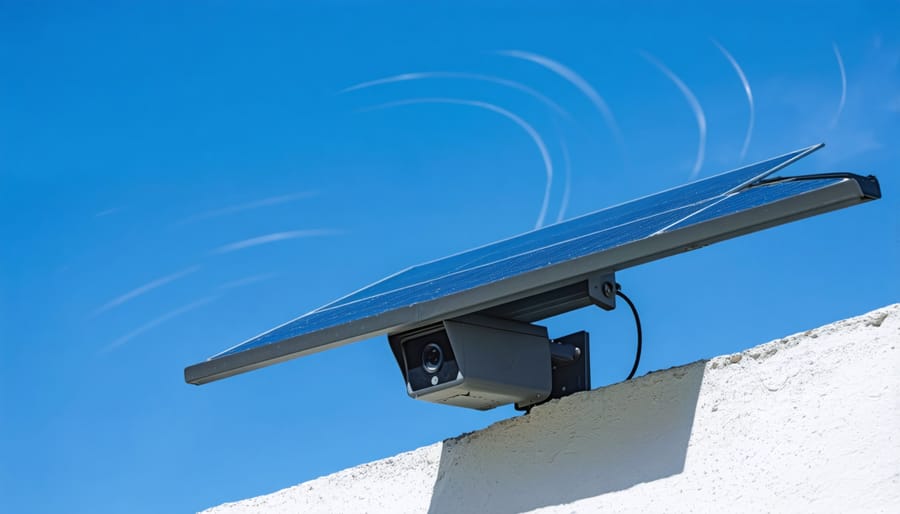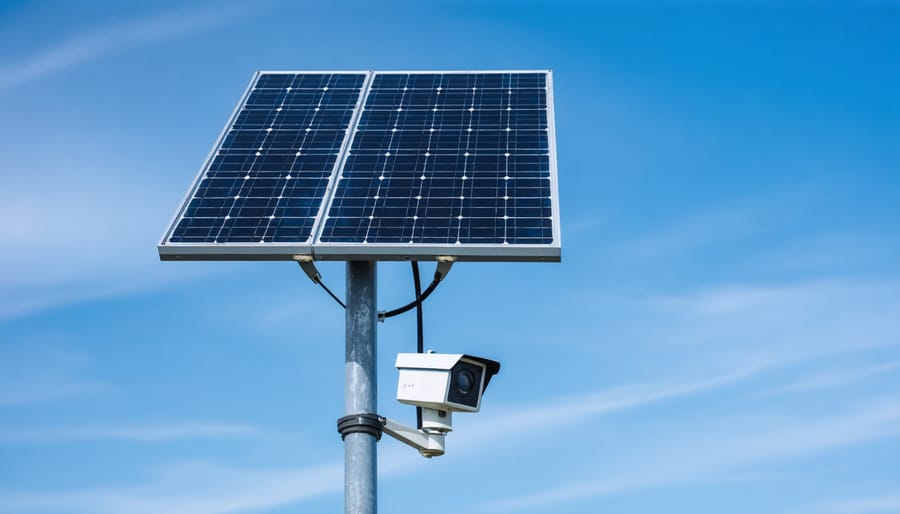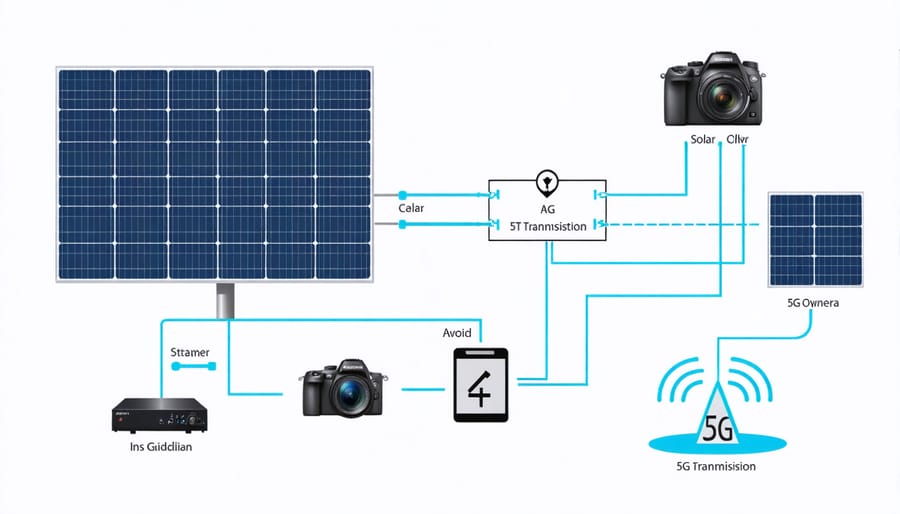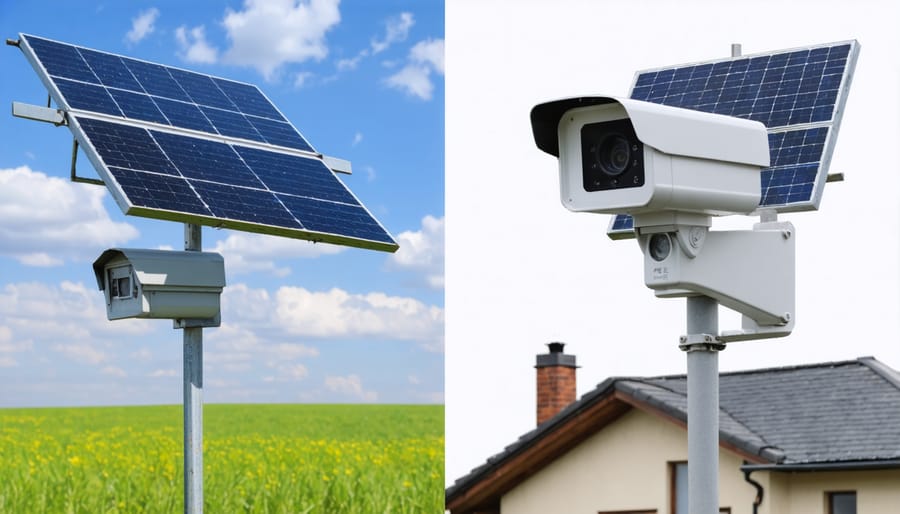5G Solar Security Cameras: The Future of Self-Powered Surveillance is Here

Revolutionizing property surveillance, solar-powered security cameras integrated with 5G connectivity represent a significant leap forward in sustainable security technology. These cutting-edge devices merge three transformative technologies—5G networks, solar power, and advanced surveillance—to deliver unparalleled monitoring capabilities without conventional power constraints.
Operating independently from the grid, these systems harness solar energy to maintain continuous surveillance while utilizing 5G’s ultra-low latency and enhanced bandwidth to transmit crystal-clear footage in real-time. For European property owners and businesses, this breakthrough combination addresses two critical challenges: maintaining reliable security coverage in remote locations and reducing operational costs through renewable energy.
The integration of 5G technology enables these cameras to process and transmit high-definition video feeds instantly, while their solar-powered nature eliminates the need for complex wiring infrastructure. This self-sustaining approach to security not only promotes environmental responsibility but also ensures consistent operation during power outages, making them particularly valuable for critical infrastructure protection and remote site monitoring.
How 5G Solar Security Cameras Transform Surveillance
Enhanced Real-Time Monitoring
The integration of 5G technology revolutionises real-time monitoring capabilities in solar-powered security cameras, delivering unprecedented video quality and response times. With data transmission speeds up to 10 times faster than 4G networks, these cameras can stream crystal-clear 4K video footage with virtually no delay, ensuring you never miss crucial details during surveillance.
The enhanced bandwidth enables simultaneous streaming from multiple cameras without compromising quality, while latency rates below 10 milliseconds provide truly real-time monitoring. This means security personnel can make split-second decisions based on live footage, particularly valuable for commercial premises and industrial facilities.
Advanced compression technologies, optimised for 5G networks, ensure efficient data transmission while maintaining high image quality. The improved connectivity also supports advanced features like AI-powered motion detection and facial recognition, which process data more reliably and rapidly than ever before.
For European businesses and homeowners, this translates to more dependable security monitoring, especially in remote locations where traditional internet connectivity might be challenging. The combination of solar power and 5G creates a self-sustaining, high-performance security solution that meets modern surveillance demands.
Sustainable Power Management
Modern 5G solar-powered security cameras incorporate advanced power management systems that maximize solar power efficiency while ensuring continuous operation. These systems typically combine high-capacity lithium-ion batteries with intelligent charge controllers that optimize energy harvesting during peak sunlight hours.
The integrated battery systems usually provide 3-7 days of autonomous operation, depending on usage patterns and environmental conditions. Smart power distribution algorithms automatically adjust camera settings based on available power, prioritizing essential functions during low-light or cloudy periods.
Most models feature dual-charging capabilities, allowing the batteries to be recharged through both solar panels and traditional power sources when necessary. The advanced power management interface provides real-time monitoring of battery levels and charging status through mobile applications, enabling users to optimize their system’s performance.
To enhance sustainability, these cameras incorporate sleep modes and motion-activated recording, significantly reducing power consumption during inactive periods. The latest models also feature weather-resistant solar panels with anti-reflective coatings, improving energy capture in various European climate conditions.

Technical Specifications and Components
Solar Panel Integration
The solar panel integration in 5G security cameras represents a significant advancement in sustainable surveillance technology. These systems typically feature high-efficiency monocrystalline solar panels, ranging from 20W to 60W depending on the camera’s power requirements and geographical location. The panels are engineered to maintain optimal performance even in varying light conditions, with conversion rates typically reaching 21-23%.
For reliable operation, the solar array connects to a sophisticated power management system incorporating lithium-ion batteries (usually 10,000mAh to 20,000mAh capacity). This configuration ensures continuous camera operation for 5-7 days without sunlight, making it particularly suitable for European climate conditions.
The solar panels are designed with a tilt-adjustable mounting system, allowing for optimal positioning between 30-45 degrees to maximise solar exposure. Most models include an integrated MPPT (Maximum Power Point Tracking) controller, which enhances charging efficiency by up to 30% compared to traditional charging methods.
Installation flexibility is a key feature, with panels typically measuring 670x350mm for 30W versions, making them compact enough for discrete mounting while maintaining sufficient power generation. The system automatically regulates power consumption based on available sunlight, adjusting features like night vision and motion detection to optimise energy usage while maintaining essential security functions.

5G Connectivity Features
The integration of 5G connectivity revolutionises solar-powered security camera capabilities, offering unprecedented speed and reliability for real-time monitoring. These advanced cameras leverage 5G networks to deliver ultra-high-definition video streaming with minimal latency, ensuring crystal-clear footage even in challenging conditions.
With download speeds reaching up to 10 Gbps, 5G-enabled security cameras can transmit large video files instantly, making them ideal for applications requiring immediate response times. The network’s enhanced capacity allows for simultaneous connection of multiple cameras without compromising performance, perfect for comprehensive security systems in both residential and commercial settings.
A key advantage of 5G technology is its network slicing capability, which ensures dedicated bandwidth for security applications. This feature maintains consistent performance regardless of network congestion, essential for round-the-clock surveillance operations.
The 5G module’s power efficiency complements the solar power system, optimising energy consumption while maintaining high-performance connectivity. Advanced power management protocols ensure the camera remains operational even during periods of limited sunlight, making these systems particularly suitable for European climate conditions.
Furthermore, 5G’s improved coverage and penetration capabilities ensure reliable connectivity in areas where traditional networks might struggle, including remote locations and dense urban environments. The network’s enhanced security protocols also protect against cyber threats, ensuring your surveillance system remains secure and private.
Installation and Maintenance Considerations
Optimal Positioning
The effectiveness of your 5G solar-powered security camera heavily depends on two crucial factors: solar exposure and network connectivity. For maximum energy generation, consider optimal solar panel positioning by mounting the camera on south-facing surfaces at a 30-45 degree angle in most European locations. Avoid areas with frequent shade from trees, buildings, or other structures that could compromise solar charging efficiency.
For reliable 5G connectivity, position the camera within clear line of sight of nearby 5G towers while maintaining adequate height above ground level. Installation at 3-4 metres provides good coverage while remaining accessible for maintenance. Consider using signal strength testing tools during installation to identify the strongest connection points.
Weather resistance is another vital factor – ensure the camera is mounted securely and protected from harsh elements while maintaining ventilation. For optimal performance in both aspects, consider seasonal adjustments: slightly steeper angles during winter months for better solar collection, and periodic cleaning of the solar panels to prevent dust or debris accumulation.
In areas with limited 5G coverage, consider using signal boosters or selecting elevated mounting positions to enhance connectivity while maintaining effective solar charging capabilities.
Long-term Care
To ensure your 5G solar-powered security camera maintains optimal performance over time, regular maintenance and proper care are essential. Start by establishing a quarterly cleaning routine for the solar panels – gentle wiping with a soft, damp cloth removes dust and debris that can reduce charging efficiency. During winter months in European climates, check more frequently to clear snow or frost accumulation.
Monitor the battery health through your system’s management app and consider replacing the battery every 3-5 years, depending on usage patterns and environmental conditions. Keep vegetation trimmed around the camera and solar panel to prevent shading and maintain maximum solar exposure.
Regularly update the camera’s firmware to ensure optimal 5G connectivity and security features remain current. Inspect mounting brackets and connections annually, tightening any loose components and checking for signs of weather damage or corrosion.
For optimal performance, adjust the solar panel’s angle twice yearly to account for seasonal changes in sun position. During extended periods of cloudy weather, consider enabling power-saving features to conserve energy. Additionally, maintain a clear line of sight between the camera and your local 5G network antenna to ensure consistent connectivity.
Store your system’s documentation and maintenance records digitally, including warranty information and service dates, for easy reference and warranty claims if needed.

Applications and Use Cases
Residential Security
The integration of 5G solar-powered security cameras has revolutionized residential security applications, offering homeowners unprecedented control and peace of mind. These innovative devices provide continuous surveillance without depending on grid power, making them ideal for properties of all sizes. The combination of solar energy and 5G connectivity ensures reliable, high-quality video streaming and remote access, even in areas with challenging weather conditions.
These systems excel in comprehensive property monitoring, offering features such as motion detection, night vision, and real-time alerts directly to your smartphone. The solar panels are designed to maintain camera operation throughout the year, while built-in batteries store excess energy for nighttime or low-light conditions. Modern models include AI-powered recognition systems that can distinguish between humans, vehicles, and animals, reducing false alarms significantly.
Installation is straightforward, with most systems requiring only strategic placement for optimal sun exposure and network connectivity. The cameras’ weather-resistant construction ensures durability in European climates, while their sleek design integrates seamlessly with modern architecture. Advanced encryption protocols protect your footage from unauthorized access, addressing privacy concerns that are particularly relevant in European markets.
For homes with multiple entry points or large gardens, these cameras can be interconnected to create a comprehensive security network, all powered by sustainable solar energy.
Commercial and Industrial Applications
In commercial and industrial settings, 5G solar powered security cameras are revolutionising site monitoring and safety protocols across Europe. These sustainable surveillance solutions prove particularly valuable in remote industrial locations, construction sites, and large commercial properties where traditional power infrastructure might be limited or costly to install.
Manufacturing facilities benefit from these cameras’ ability to monitor production lines and outdoor storage areas with crystal-clear 4K video streaming, enabled by reliable 5G connectivity. The solar power component eliminates the need for complex electrical installations, making them ideal for temporary construction sites or rapidly expanding industrial parks.
Logistics centres and warehouses deploy these systems to secure vast perimeter areas and loading docks, with the high-speed 5G transmission enabling real-time monitoring of multiple camera feeds simultaneously. The integration with smart AI systems allows for automated inventory tracking and enhanced theft prevention.
Agricultural businesses utilise these cameras to monitor crops, livestock, and equipment across expansive properties. The solar-powered nature ensures consistent operation even in remote fields, while 5G connectivity enables instant alerts and live video access from anywhere.
For retail parks and commercial complexes, these systems offer comprehensive security coverage without increasing energy costs. The combination of solar power and 5G technology ensures continuous operation during power outages, providing uninterrupted security monitoring for business-critical areas.
The integration of 5G technology with solar-powered security cameras represents a significant leap forward in sustainable surveillance solutions. These innovative devices offer an impressive combination of reliability, high-performance monitoring, and environmental responsibility that perfectly aligns with Europe’s green initiatives. The elimination of traditional power constraints, coupled with ultra-fast 5G connectivity, enables unprecedented capabilities in remote monitoring and real-time response.
Looking ahead, the future of 5G solar security cameras appears increasingly promising. As solar panel efficiency continues to improve and 5G infrastructure expands across European territories, these systems will become even more accessible and powerful. The technology is expected to play a crucial role in smart city development, industrial security, and residential protection while supporting the EU’s renewable energy goals.
For businesses and homeowners alike, investing in 5G solar security cameras represents a forward-thinking approach to security that combines innovation with sustainability. As the technology matures, we can expect to see enhanced AI capabilities, improved energy storage solutions, and more sophisticated integration with smart home systems, making these devices an increasingly integral part of modern security infrastructure.
Leave a Reply